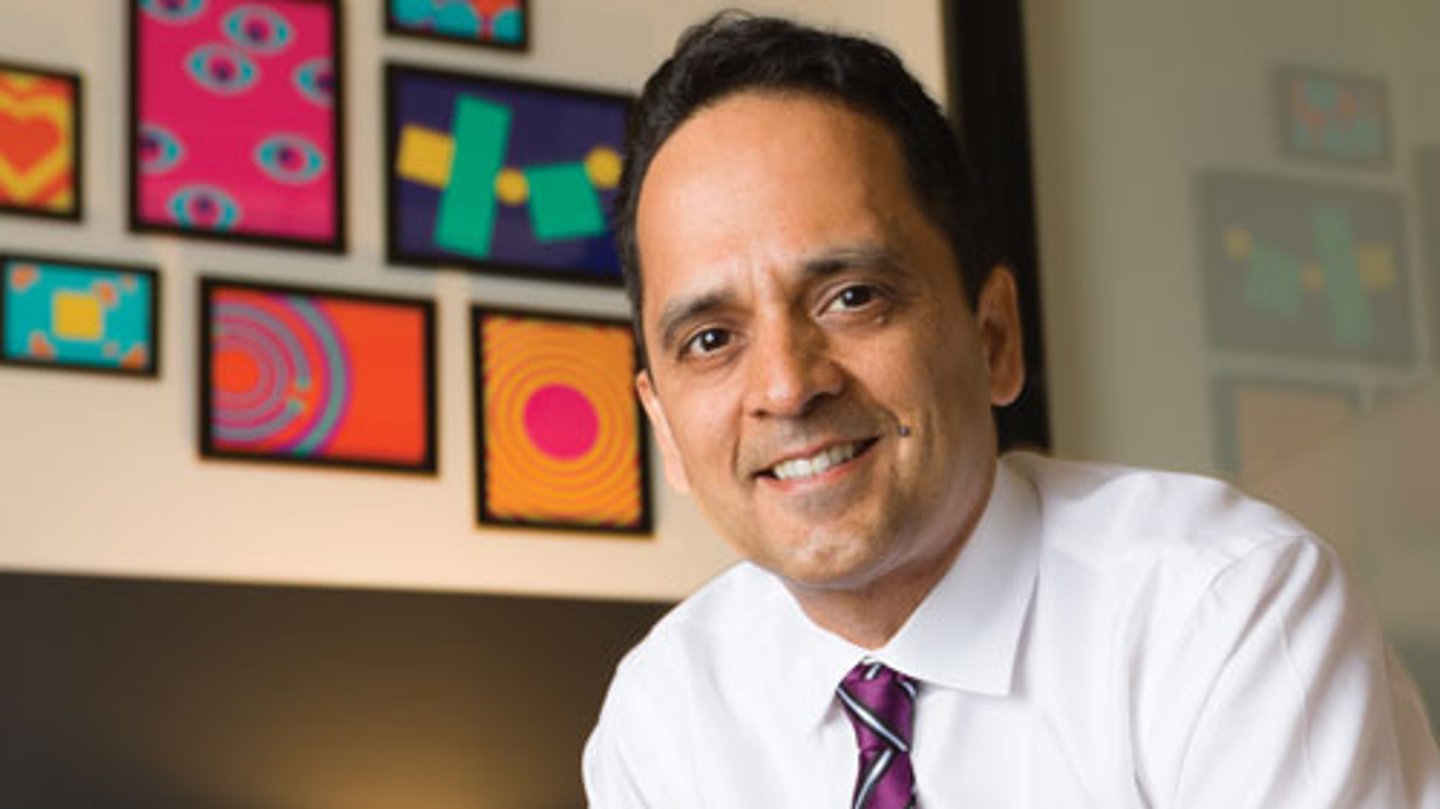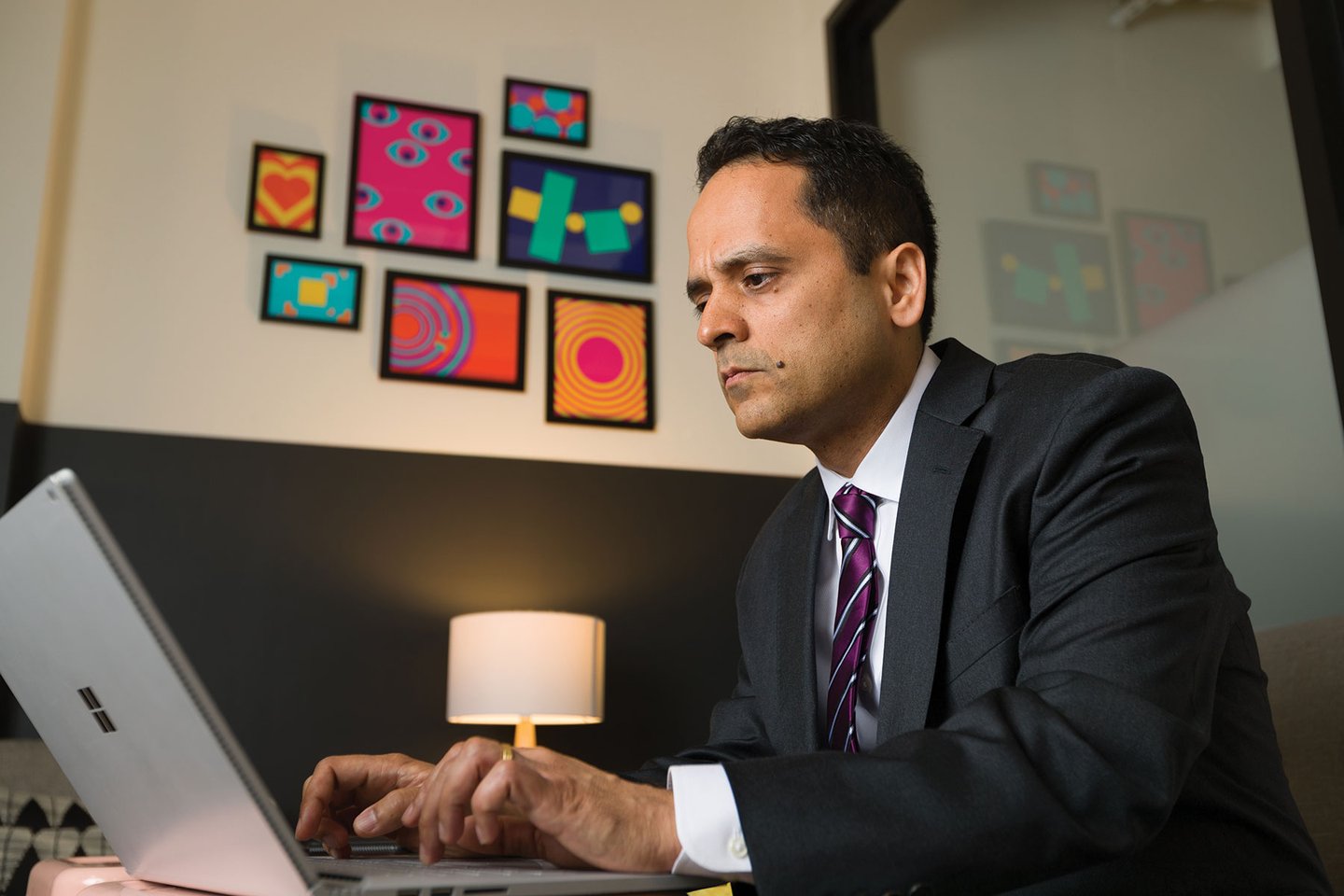CIO of the Year 2019: Sandeep Dadlani, Mars Incorporated
As chief digital officer, Dadlani is helping Mars move faster to better solve the evolving needs of consumers and customers
One might say that Sandeep Dadlani wants to help turn Mars from a Cadillac into a Corvette. Mars is a family-owned business with more than a century of history making diverse products and offering services for people and their pets. With more than $35 billion in annual sales, the global company produces some of the world’s best-known brands, including M&M’s, Snickers, Skittles, Whiskas and Uncle Ben’s. And most importantly, it fosters a culture of humility that embraces change, according to Dadlani. But in this age of relentless digital upheaval, the one thing Mars still covets is speed.
“When I really listened to everyone, including our consumers and customers, the one thing everyone wanted Mars to be was faster – and not just 10% faster but perhaps 100 times faster,” Dadlani recalls of his early days at the company. “The question became: How do you inject speed into a large, global organization?”
Dadlani joined Mars in September 2017, replacing the outgoing chief information officer and assuming an expanded role of chief digital officer. The title change was not just a matter of semantics. At a time when Mars is undergoing perhaps the most significant evolution in its more than century-old history – the company has been aggressively expanding into new businesses and is extremely optimistic about expected revenue from services in the next 10 years – the newly created position was meant to signal leadership’s commitment to wholesale digital transformation.
About the Award
This award is given to the chief information officer who has made the greatest demonstrable business impact on his or her organization through the implementation and use of technology.
Each year, we solicit formal nominations from members of the Path to Purchase Institute community. Institute editors select no more than five finalists from among the qualified submissions to be considered in the official voting round, for which the editors enlist the experience and expertise of our Executive Advisory Council.
Previous winners of this 7-year-old award were Jane Moran of Unilever, Manjit Singh of Clorox Co., Sai Koorapati of Callaway Golf, Mark Dajani of Mondelez International, David Stahl of Hillshire Brands, and Ralph Loura of Clorox.
“As we transform from a CPG company to a broader consumer goods and services company, the conversation has been laser-focused around driving speed and a digital movement within Mars,” says Dadlani, who leads a global digital organization across all of Mars’ business units. “Ultimately, titles are immaterial. We’re not solving for information, or even digital. We’re solving for growth, consumer relevance and speed.”
To carry out a new “digital first” vision for Mars, Dadlani first had to ingrain the idea that digital is “anything that drives speed” throughout the organization. “We couldn’t define digital as e-commerce, because the supply chain guys would say, ‘I want to be digital, too.’ Or as operations, because the salespeople would say, ‘What about me?’” he says. “So we clearly defined digital as something that helps us go 100 times faster – not to second-guess what we’re trying to do, but wanting to go faster. In that way, the relationship around speed became clear.”
By combining data analytics, AI and automation with design thinking principles and techniques (such as breaking down business challenges and their solutions into sprints), Dadlani helped develop an approach that would let Mars adapt its business practices and consumer strategies at a much faster rate. The model is based on three pillars: identifying the right problem using “user-centricity”; solving the problem with data analytics; and scaling up the solution using automation. This is the Mars digital engine.
“The most important capability in becoming a digital learner is being able to ask the right question,” says Dadlani. “It’s the ability to form a more specific, granular, user-centric question that allows every Mars Associate to leverage data science and take our collective performance to the next level.”
Dadlani recalls how one Mars team used a nine-month program broken down into 12-week sprints to successfully remove a demand forecast error in the supply chain. “Initially, we thought the problem was around customer service levels – how much did a retailer customer order versus how much was fulfilled,” he explains. “We collected all the end-user data from demand planners, supply planners and domestic planners to frame the problem carefully. After we completed a design workshop, we learned it was a human problem of visibility and collaboration with data sources and forecasting tools.”
Mars employed AI and machine learning tools to bring the forecast error down dramatically, though Dadlani says that’s not really the point. “It’s about the human evolution that the team went through to see the value that, when [all end users] have the same view of inventory and demand signals across thousands of SKUs and multiple factories and warehouses and the same view of the next 12 weeks of planning, then the forecast error comes down anyway. With AI, it comes down even more.”
That’s just one example of how Mars has unlocked the power of data and analytics over the past 18 months. “Other areas include how we drive strategic revenues, pricing, effectiveness of displays, e-commerce analytics, social listening and routes to markets in terms of how we invest our sales teams,” he says.
Digital Moments That Matter
Technology is playing a vital role in the transformation of Mars’ core businesses, as well as the company’s expansion into new categories such as pet services and targeted human health and nutrition. In each of these areas, Dadlani sees a huge opportunity to generate growth by increasing consumer engagement in what he calls the “digital moments that matter.”
“We recently did an analysis and found that the five to seven minutes that a mom is waiting to pick up her child outside a school is a free browsing period online – a digital moment where she may need energy, recharge or a pickup,” says Dadlani. “Pet owners may find that they need additional help when they first acquire a pet and they’re willing to be guided. This need may lessen as they go forward but then re-emerges toward the end of the pet’s life.”
Mars has been expanding into pet services to complement its core CPG business, which includes leading pet food brands Royal Canin, Iams and Pedigree. The company is now the largest employer of veterinarians across the globe, according to Dadlani, having acquired animal hospital chains including Banfield Pet Hospitals, BluePearl, Linnaeus, AniCura, VCA and Pet Partners. “We continue to expand our vet hospital services to make a better world for pets, which is our stated vision for the pet care business,” he notes.
Technology provides an accelerator to help pet owners understand and meet the health and nutrition needs of their pets. Mars Petcare is developing new genealogy services through its Wisdom Health division and addressing the growing demand for monitoring pet activity through its acquisition of Whistle, best explained as the “Fitbit for pets.”
“When we create a permissible data ecosystem of the tens of millions of pets we serve all over the world every day, then we acquire newer capabilities to understand these pets and perhaps [for example] predict diseases that may be prevented, suggest nutritional interventions, or find a pet that’s lost,” says Dadlani. “Technology, data and unique new experiences enable us to partner with everybody in that ecosystem: veterinarians, breeders, dog walkers, shelters, groomers – and the most valuable player, the pet parent – to help guide them through their journey.”
Elsewhere, Mars is charting new territory in personalized nutrition through its Mars Edge segment. The company recently announced a majority stake in Berlin, Germany-based Foodspring, a direct-to-consumer sports nutrition startup and one of the fastest-growing targeted nutrition businesses in Europe. “We’re moving from a one-size-fits-all food company to what is specifically right for ‘Me,’ [creating] a global targeted nutrition business that is all about data, AI and personalization,” says Dadlani.
From left to right (above): Constance Smith, Global Director, User Centricity (Innovation & Design), Mars; Fabio Alves Da Silva, Americas Industry Engineer Director, Royal Canin; Jason Ripper, Senior Manager, Mars Corporate Affairs; Sandeep Dadlani, Chief Digital Officer, Mars; Alicia Tyree, Senior Manager, Strategic Beacons, Mars; and Reid Rousseau, Senior Manager, User Centricity Program Lead, Mars. (Photo by Steve Hockstein)
Getting Closer
Success for CPGs today depends on the ability to leverage technology (Dadlani prefers the more-specific term “broader digital capabilities”) to get closer to consumers. For Mars, that includes using data analytics and automation to create new immersive experiences, such as the ones at the M&M’s World stores involving the interactive Mood analyzer and personalized M&M’s to create custom treats for birthdays and other special events.
“It’s clear to us that permissibility and ‘premiumization’ are very important trends in the confectionery and gum categories,” says Dadlani. “If you look at the top line, some of these categories are challenged for growth” due to health-conscious shifts in consumption patterns. “But if you dive deeper into each category and get closer to the consumer, listen socially for trends and in different markets for occasions and moments where consumers love to, on a permissible basis, consume, celebrate, recharge, … then it becomes a category that we can look at with great possibilities and pride.”
The same principles apply to Mars’ business partners. “It’s clear that data and digital tools allow us to get closer to the consumer and pet owner. Less obvious is that the same set of data and analytics allows us to serve our channels and our large retail customers with better insights to drive category growth – whether it’s better packaging, pricing, placement, promotions and displays,” says Dadlani. “This is an area we’ve focused on heavily in our first two years and has allowed our retail customers to join into our vision of creating a better world for pets.”
On the candy side, Mars wants to further leverage insights from the millions of visitors who walk through the standalone M&M’s stores each year. Since the iconic Times Square location is the starting point for many New York City sightseeing buses, “Every tourist starts out at the M&M’s store,” laughs Dadlani, who has a non-stop feed of consumer trends flowing into his office in the form of a live video stream from the store.
“We have the opportunity to see what’s going on with consumers in an immersive environment,” says Dadlani. “It all boils down to that mother with the stroller waiting for her 10-year-old child to run around the store and collect the one item he wants that she can buy for him.”
Learning from Within
Dadlani’s confidence in his organization’s ability to embrace digital learning can be traced back to an internal mailing error early in his tenure. “We launched an advanced machine learning course for a small group of tech-oriented people, and the mailer accidentally went out from my ID to thousands of associates,” he recalls. To his surprise, many of those unintended recipients showed up. “That changed our thinking about how ready everyone in the organization was to take on the challenges of new technology.”
Dadlani also credits the support of Mars’ segment and corporate business leaders, a fantastic team of digital technology leaders, and a strong educational infrastructure led by Mars University, which has grown in the past two years thanks to partnerships with technology/content providers such as Udacity and Ideo. “We’re finding some of the best data analytics sprints coming from our manufacturing factories. They’re great sources of innovation,” Dadlani notes. “We’re [enhancing] daily work with user-centricity, analytics and automation. Even simple movements like My Analytics (an initiative to enable all users with self-service reporting and analytics tools like Tableau and Power BI) allow us to go everywhere in the world, converting thousands of associates to unlock the power of data and data boards.”
Hundreds of such initiatives, supported by internal social networks like Yammer, bring the user-centricity and digital movement to life within Mars, says Dadlani. “We’re still learning as we go, and yes, there are some misfires and mistakes. But overall, so far so good.”
But the most dramatic change continues to involve speed. “As marketers, we have a choice: We can go for the next six months devising a precise, scientific way of launching a new product; that may give you a super-precise answer, but by that time consumers may have moved on anyways. Or, we can finish a ‘good enough’ analysis in three days that answers the question that we’re trying to solve for today,” says Dadlani. “That creates speed, which in turn allows us to launch in a week. And in four weeks, we come back with lots of learnings, including mistakes. Then, in the following four weeks, we change a lot of things and drive faster growth.”
He cites ongoing work around the launch of a new food product in an established market. “The problem we were trying to solve was not how to launch a product but how, with limited resources, we can quickly drive adoption and trial in our top-10 store clusters. When you frame the problem that way, and then look at the data we have around demographics, sales for similar products and some extrapolated data with other free sources, within a day we have a model that allows us to know broadly which clusters to focus on – at least for the first few weeks.”
Despite the successes Mars has achieved with digital, Dadlani isn’t resting. “We never will have completed a transformation because the world is changing so fast,” he acknowledges. “This is a speed journey and we’re just beginning to accelerate. My hope is that when we can get to 100 times faster, that becomes the new normal. What we need is speed, an always-learning attitude and consistency with our purpose, our principles and our humility. I have no doubt that this company and its wonderful leaders have the right ingredients.
“This award is definitely not for one person or one team,” Dadlani says. “It’s a fantastic testament to the 125,000 ‘Martians’ who everyday strive hard to go faster, to go digital, and to make us all proud.”
CIO of the Year Finalists
A shout-out to some of this year’s other noteworthy nominees
Kevin Gokey, CIO, Church & Dwight
Gokey is a 20-year Church & Dwight veteran who’s served as CIO since December 2014. He has defined and delivered IT strategy across the company globally, including initiatives in data analytics and business intelligence, cloud-first infrastructure, and a secure, scalable environment with highly optimized development and support services. Gokey drives digital transformation through the implementation of new technology.
Gokey nutures strong relationships with all business unit leaders to make IT a true partner and business enabler, ensuring that tech solutions are aligned with the company’s objectives. He also proactively advises senior management on the emerging technologies and digital trends that are most relevant to their goals and needs. For his team, he fosters a culture of innovation, transparency and accountability and maintains a clear plan for succession and continuity in critical management positions. Gokey consistently monitors industry trends to find relevant new tools and service management frameworks.
Paul Karras, CIO, Hu-Friedy Manufacturing
Since joining Hu-Friedy in 2017, Karras has been implementing a strategic approach to IT that aligns corporate initiatives with technological capabilities. He is leading the dental equipment manufacturer on a holistic digital transformation that is reinventing operating models, production and value chains to secure a foundation for growth and competitive advantage.
Karras’ track record of driving enterprise-wide strategic initiatives has enabled Hu-Friedy to leverage technology to improve efficiency and communication across its international footprint. His vision for an interconnected workforce was accomplished through a combination of internal systems and external tools (including Okta to facilitate access management and Salesforce to improve company-wide CRM capabilities). Elsewhere, an in-house cleansing of transactional data paved the way for a new Customer Excellence Action Team that aligns stakeholders across the organization to use insights gleaned from Salesforce to develop marketing campaigns and product messaging.
Arnold Leap, CIO, 1-800-Flowers.com, Inc.
As CIO since 2013, Leap has played an integral role in the company’s digital transformation by staying ahead of innovation and identifying cutting-edge ways to increase operating efficiencies through technology.
One of Leap’s more impactful initiatives was the integration of the company’s one dozen brands — which include Harry & David, Cheryl’s Cookies, Simply Chocolate, and Personalization Universe, along with the flagship — into a single, intuitive hybrid platform called Celebrations that gave shoppers a one-stop gifting destination for all celebratory occasions.
Not surprisingly, the effort involved uncoupling the massive complexities in each brand’s existing platform, which functioned as an independent entity with its own legacy system before being acquired by 1-800-Flowers.com. The key to success was extrapolating the business logic from these systems and applying new layers of micro-services to modernize how the brands operate and coexist. The result was an agile, multi-brand platform and a formula for seamlessly absorbing new systems as needed.
Bud McQuade, Vice President of Information Technology, Duracell
McQuade joined Duracell in July 2015 to help the global battery leader transition from a Procter & Gamble brand to a company in the portfolio of investment house Berkshire Hathaway. He therefore was instrumental in developing and implementing the IT vision and strategy under which Duracell now operates. Current areas of responsibility include business applications, IT infrastructure, end user support, enterprise architecture, business intelligence, information security, project management and vendor management.
Among McQuade’s more noteworthy accomplishments was an effort over the last year to standardize Duracell globally on a single demand signal repository platform to capture and harmonize all customer POS data. The project required the onboarding of more than 80 countries-worth of retailer POS data. Duracell now can leverage the combined data for better demand planning and demand sensing, as well as to efficiently track the ROI of trade spending.









